Applause for Cauliflower!
Cauliflower has gone from a boring side dish to one of the “It” veggies of the 2020s. This crucifer’s versatility is matched only by its powerhouse nutritional profile. This is one vegetable well deserving of rounds of applause!
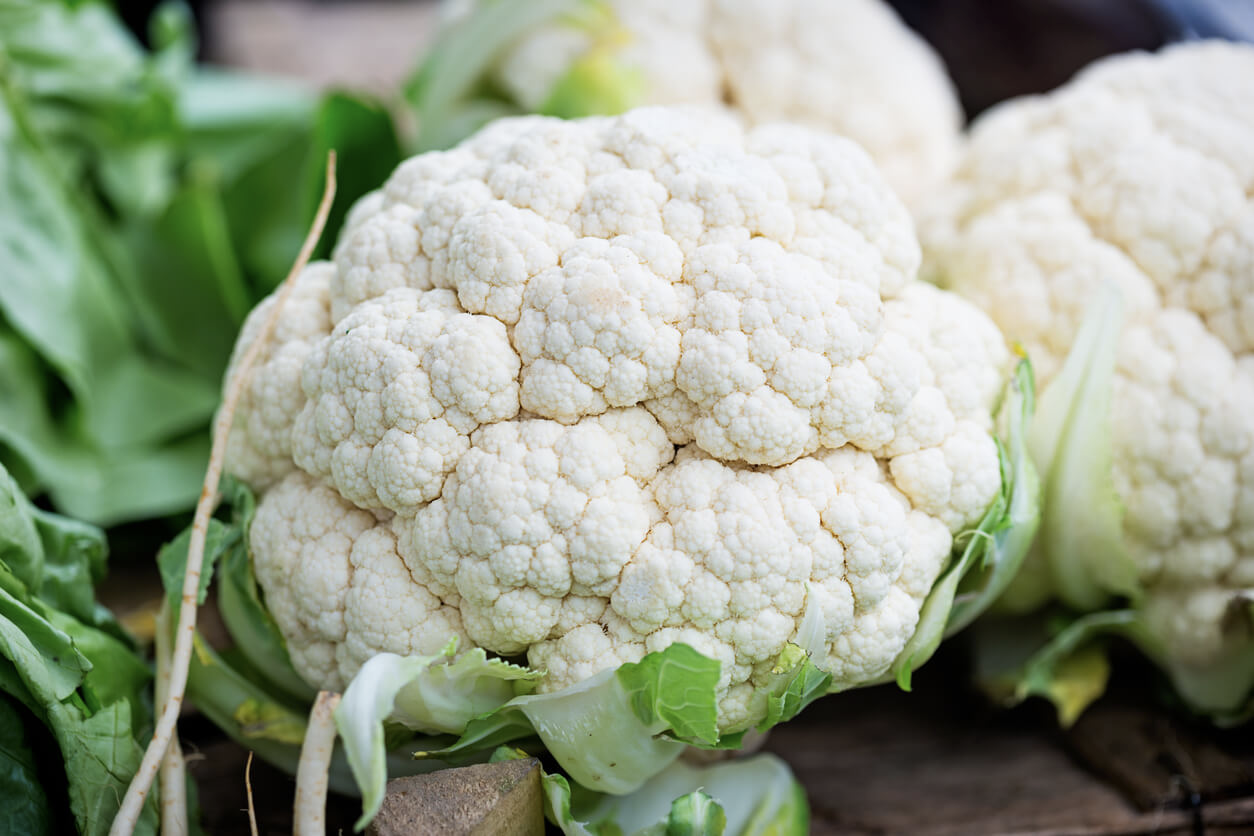
There was a time when cauliflower, much like its awkward cousin, broccoli, was considered a bland, boring, and stinky dish. But that was only because it was abused—overcooked and under-seasoned.
But now, it’s enjoying a hip makeover as a meat and starch substitute, transforming into cauliflower “wings,” “steaks,” and “rice.” Folks are giving it a thumbs-up as a low-carb, gluten-free substitute for bread and pasta. And it’s now common to find riced cauliflower and cauliflower pizza crust in the freezer section of most grocery stores.
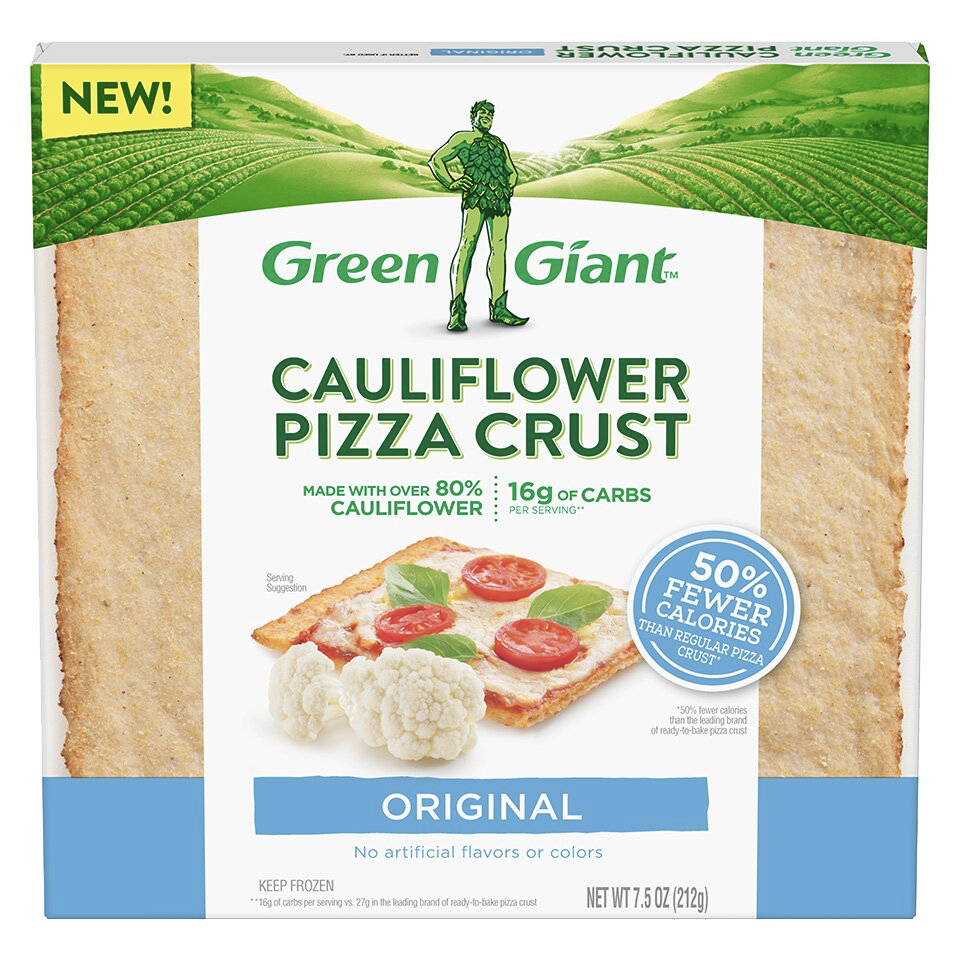
Besides its culinary popularity, there are its extraordinary health-promoting powers. While high in vitamins, minerals, phytonutrients and trace elements, cauliflower is especially noteworthy is its anti-cancer properties. All the research supports dining on cauliflower at least weekly.
We’re all familiar with the white variety, but perhaps you’ve noticed it’s now showing up in some fun colors such as green (aka broccoflower and has a crunchier texture and sweeter, but nuttier flavor), orange (containing more beta-carotene than white), and purple (HIGH in anthocyanins and antioxidants)?
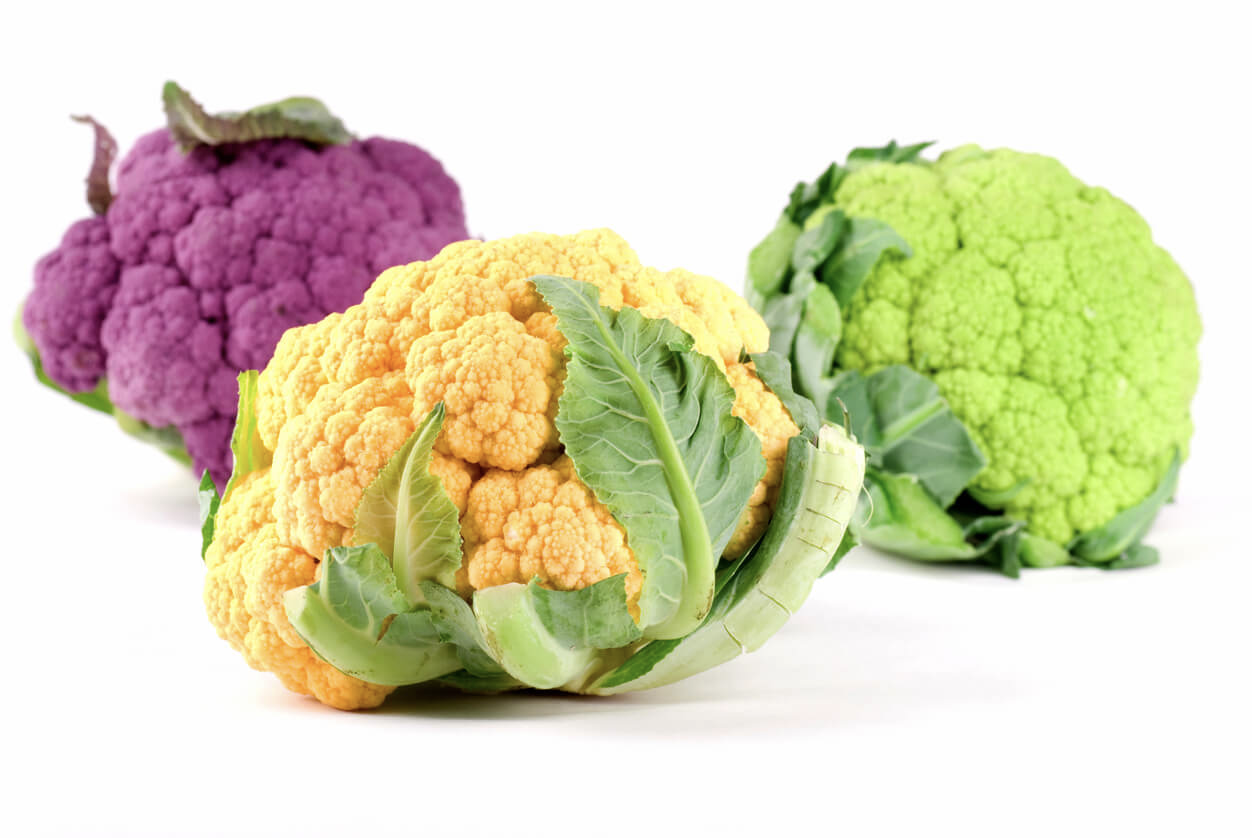
When preparing, avoid boiling. This approach leads to the stinky kitchen. Instead, lightly steam it. And then there’s roasting…when seasoned properly, thin slices of roasted broccoli are as good as it gets. But research shows you’ll get the most nutrition bang for your buck by eating it raw. I like to chop it fine and sprinkle it over my tossed green salads or pair florets with a hearty ranch dressing.
All this said, there is a little concern around digestive discomfort. This comes if you’re not used to eating it, which is largely because it contains raffinose. Raffinose is a type of oligosaccharide that doesn’t digest completely, and thus ferments in the large intestine. For a small number of people (including those with IBS), raffinose causes gas, abdominal bloating and pain, constipation, or diarrhea.

Raffinose and other oligosaccharides aren’t total villains, however. They’re actually a type of prebiotic fiber, which feeds good gut bacteria in the digestive tract. So, the point is, if you’re new to cauliflower, simply start off with small quantities to allow your gut microbiome to acclimate.
And one other happy piece of news: The Environmental Working Group (EWG), which tests an array of produce every year to determine how contaminated they are, has put cauliflower on the “Clean 15” list. This means it’s among the types of produce least likely to have contamination from agricultural chemicals like pesticides. And according to the USDA’s Pesticide Data Program, half of the cauliflower samples tested in 2012 didn’t show any pesticide residue at all.
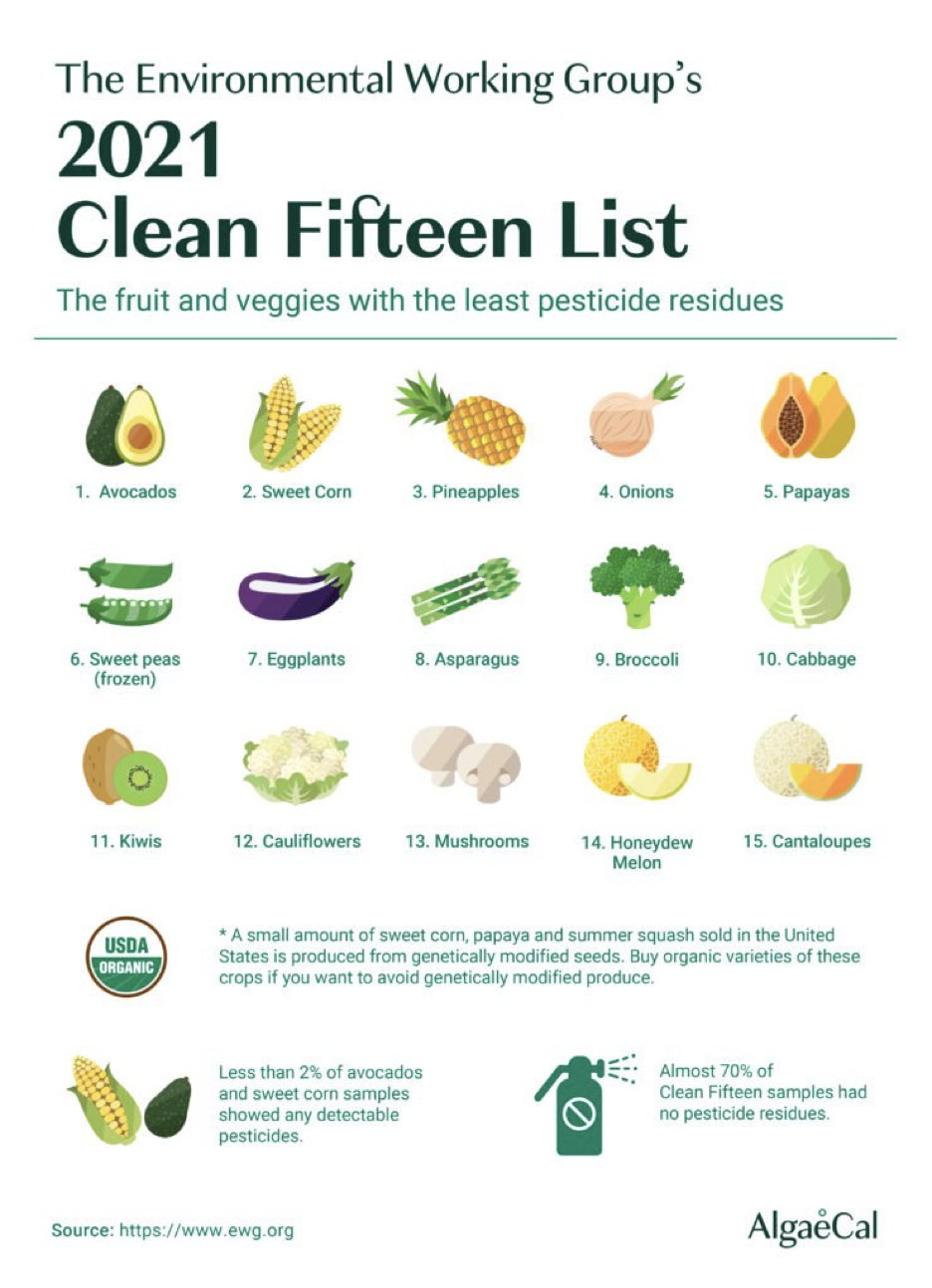
I’ll close with one of our favorite recipes, a cauliflower-based dish that explodes with flavor due to being paired with onions, broccoli, carrots, peas, corn, and pineapple. Make it a complete meal by adding some organic tofu or edamame and bean sprouts.
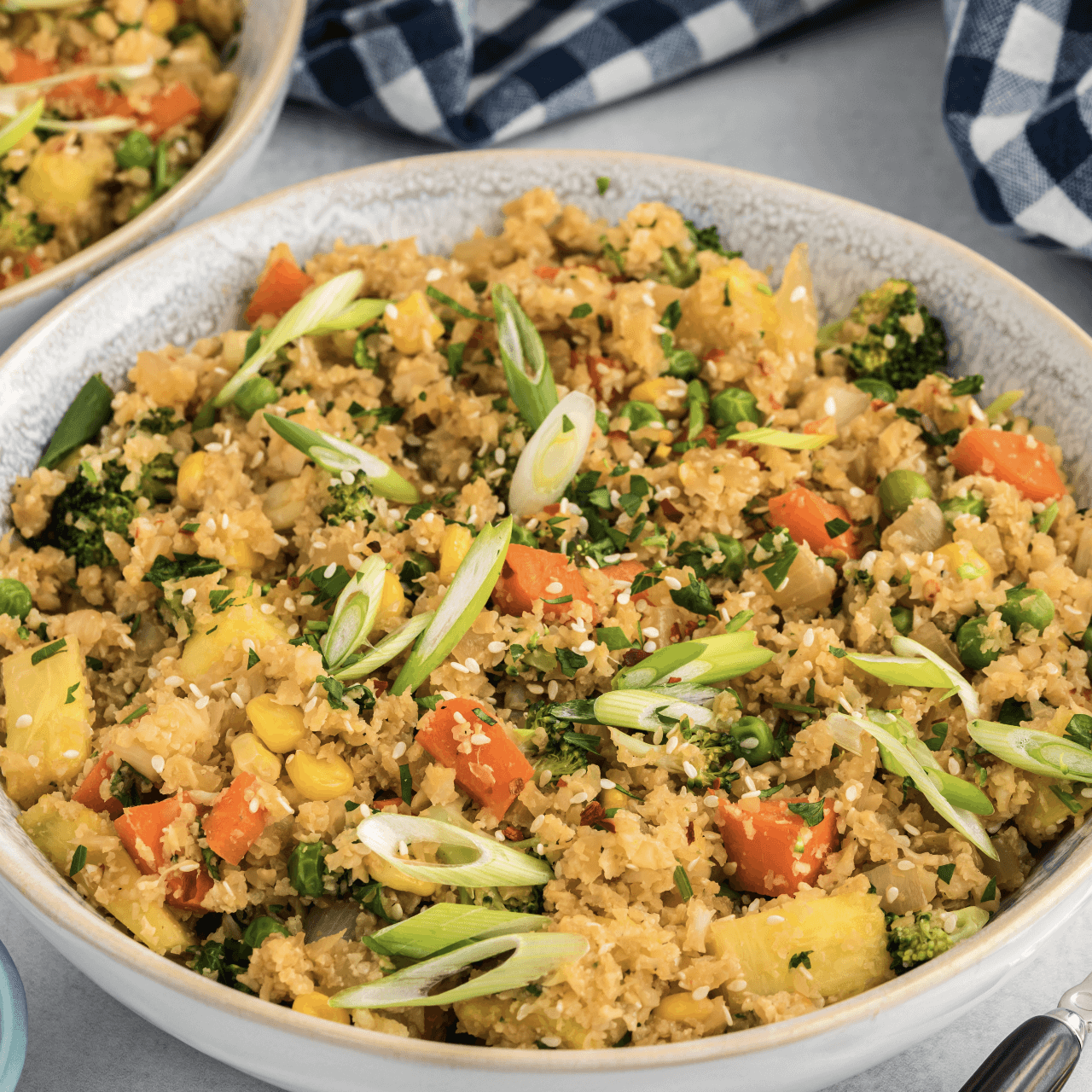
1 head cauliflower
SAUCE
3 tablespoons tamari sauce (reduced-sodium, or coconut aminos)
1/4 cup water
2 teaspoons sesame oil (optional)
1 tablespoon pure maple syrup (or date paste, link in Chef’s Notes)
1 tablespoon sherry vinegar (or red wine vinegar)
1 tablespoon fresh grated ginger
1 tablespoon fresh minced garlic
VEGGIES
1 cup diced onions
2 cups broccoli florets (chopped into ½” pieces)
1 cup diced carrots
1/2 cup peas (fresh or frozen)
1/2 cup corn (frozen or fresh)
1/2 cup chopped fresh pineapples
2 green onions (+1 as needed, green and white portions, sliced)
1/4 cup cilantro (+1/4 cups as needed, chopped, optional)
2 tablespoons sesame seeds
crushed red pepper flakes (optional, to taste)
Directions:
Add Recipe to Cook'n

There was a time when cauliflower, much like its awkward cousin, broccoli, was considered a bland, boring, and stinky dish. But that was only because it was abused—overcooked and under-seasoned.
But now, it’s enjoying a hip makeover as a meat and starch substitute, transforming into cauliflower “wings,” “steaks,” and “rice.” Folks are giving it a thumbs-up as a low-carb, gluten-free substitute for bread and pasta. And it’s now common to find riced cauliflower and cauliflower pizza crust in the freezer section of most grocery stores.

Besides its culinary popularity, there are its extraordinary health-promoting powers. While high in vitamins, minerals, phytonutrients and trace elements, cauliflower is especially noteworthy is its anti-cancer properties. All the research supports dining on cauliflower at least weekly.
We’re all familiar with the white variety, but perhaps you’ve noticed it’s now showing up in some fun colors such as green (aka broccoflower and has a crunchier texture and sweeter, but nuttier flavor), orange (containing more beta-carotene than white), and purple (HIGH in anthocyanins and antioxidants)?

When preparing, avoid boiling. This approach leads to the stinky kitchen. Instead, lightly steam it. And then there’s roasting…when seasoned properly, thin slices of roasted broccoli are as good as it gets. But research shows you’ll get the most nutrition bang for your buck by eating it raw. I like to chop it fine and sprinkle it over my tossed green salads or pair florets with a hearty ranch dressing.
All this said, there is a little concern around digestive discomfort. This comes if you’re not used to eating it, which is largely because it contains raffinose. Raffinose is a type of oligosaccharide that doesn’t digest completely, and thus ferments in the large intestine. For a small number of people (including those with IBS), raffinose causes gas, abdominal bloating and pain, constipation, or diarrhea.

Raffinose and other oligosaccharides aren’t total villains, however. They’re actually a type of prebiotic fiber, which feeds good gut bacteria in the digestive tract. So, the point is, if you’re new to cauliflower, simply start off with small quantities to allow your gut microbiome to acclimate.
And one other happy piece of news: The Environmental Working Group (EWG), which tests an array of produce every year to determine how contaminated they are, has put cauliflower on the “Clean 15” list. This means it’s among the types of produce least likely to have contamination from agricultural chemicals like pesticides. And according to the USDA’s Pesticide Data Program, half of the cauliflower samples tested in 2012 didn’t show any pesticide residue at all.

I’ll close with one of our favorite recipes, a cauliflower-based dish that explodes with flavor due to being paired with onions, broccoli, carrots, peas, corn, and pineapple. Make it a complete meal by adding some organic tofu or edamame and bean sprouts.

Cauliflower "Fried Rice"
Ingredients:
1 head cauliflower
SAUCE
3 tablespoons tamari sauce (reduced-sodium, or coconut aminos)
1/4 cup water
2 teaspoons sesame oil (optional)
1 tablespoon pure maple syrup (or date paste, link in Chef’s Notes)
1 tablespoon sherry vinegar (or red wine vinegar)
1 tablespoon fresh grated ginger
1 tablespoon fresh minced garlic
VEGGIES
1 cup diced onions
2 cups broccoli florets (chopped into ½” pieces)
1 cup diced carrots
1/2 cup peas (fresh or frozen)
1/2 cup corn (frozen or fresh)
1/2 cup chopped fresh pineapples
2 green onions (+1 as needed, green and white portions, sliced)
1/4 cup cilantro (+1/4 cups as needed, chopped, optional)
2 tablespoons sesame seeds
crushed red pepper flakes (optional, to taste)
Directions:
1. Prepare your cauliflower rice: Wash and dry cauliflower before removing the greens.
2. Cut the cauliflower florets off of the stem. Then cut the florets into smaller 1–2” pieces.
3. Add ? of the cauliflower florets to a food processor. Using the chopper attachment (the one you probably use most often!), pulse the cauliflower until chopped into rice-length pieces. Transfer the cauliflower to a bowl and repeat with the second and third portions of the cauliflower. Set aside. (See Chef’s Notes on using a box grater to make cauliflower rice.)
4. Make the sauce: Combine all ingredients to a medium bowl. Stir well and set aside.
5. Add onions and carrots to a large stovetop pan and cook on medium-high. Cook until the onions become translucent, about 3–4 minutes.
6. Turn down heat to medium and add the broccoli and cauliflower. Stir well. Cook for another 3–4 minutes. Add 1–2 tablespoons of water or vegetable broth as needed to deglaze the pan.
7. Stir in the sauce, peas and corn. Cook for an additional 3–4 minutes until the vegetables are tender.
8. Remove from the heat and stir in the pineapple, green onion, cilantro, if using, sesame seeds, and crushed red pepper, if using.
NOTES
SUBSTITUTIONS: Add other vegetables of choice in place of the vegetables listed, such as red pepper, Brussels sprouts, or leafy greens. Instead of peas, try edamame or chickpeas.
PREPARATION: You can make the cauliflower rice ahead of time and store in the refrigerator for up to 3 days before making this dish. Use a box grater for the cauliflower rice. First, cut the cauliflower into large pieces (instead of 1–2” pieces) and use the medium-sized holes to grate into “rice.”
ADDITIONS: Tofu. Stir already cooked tofu into step 5 with the peas and corn. For crispy tofu, drain and press the water out for one hour by wrapping the tofu in paper towels or a cloth towel and setting a heavy object on top (make sure to have a plate underneath the tofu so water doesn’t get all over your counter!). Cut into 1” cubes. Toss with ¼ teaspoon of salt (optional) and 1 teaspoon of garlic powder. Spread out evenly on a parchment-lined baking sheet and bake for 40 minutes at 400 degrees F, tossing halfway through.
SUGAR-FREE: Use date paste in place of maple syrup.
STORAGE: Store leftovers in an airtight container in the refrigerator for up to 5 days or in the freezer for up to 30 days.
2. Cut the cauliflower florets off of the stem. Then cut the florets into smaller 1–2” pieces.
3. Add ? of the cauliflower florets to a food processor. Using the chopper attachment (the one you probably use most often!), pulse the cauliflower until chopped into rice-length pieces. Transfer the cauliflower to a bowl and repeat with the second and third portions of the cauliflower. Set aside. (See Chef’s Notes on using a box grater to make cauliflower rice.)
4. Make the sauce: Combine all ingredients to a medium bowl. Stir well and set aside.
5. Add onions and carrots to a large stovetop pan and cook on medium-high. Cook until the onions become translucent, about 3–4 minutes.
6. Turn down heat to medium and add the broccoli and cauliflower. Stir well. Cook for another 3–4 minutes. Add 1–2 tablespoons of water or vegetable broth as needed to deglaze the pan.
7. Stir in the sauce, peas and corn. Cook for an additional 3–4 minutes until the vegetables are tender.
8. Remove from the heat and stir in the pineapple, green onion, cilantro, if using, sesame seeds, and crushed red pepper, if using.
NOTES
SUBSTITUTIONS: Add other vegetables of choice in place of the vegetables listed, such as red pepper, Brussels sprouts, or leafy greens. Instead of peas, try edamame or chickpeas.
PREPARATION: You can make the cauliflower rice ahead of time and store in the refrigerator for up to 3 days before making this dish. Use a box grater for the cauliflower rice. First, cut the cauliflower into large pieces (instead of 1–2” pieces) and use the medium-sized holes to grate into “rice.”
ADDITIONS: Tofu. Stir already cooked tofu into step 5 with the peas and corn. For crispy tofu, drain and press the water out for one hour by wrapping the tofu in paper towels or a cloth towel and setting a heavy object on top (make sure to have a plate underneath the tofu so water doesn’t get all over your counter!). Cut into 1” cubes. Toss with ¼ teaspoon of salt (optional) and 1 teaspoon of garlic powder. Spread out evenly on a parchment-lined baking sheet and bake for 40 minutes at 400 degrees F, tossing halfway through.
SUGAR-FREE: Use date paste in place of maple syrup.
STORAGE: Store leftovers in an airtight container in the refrigerator for up to 5 days or in the freezer for up to 30 days.
Recipe formatted with the Cook'n Recipe Software from DVO Enterprises.
Sources:
www.foodrevolution.org
www.eatingwell.com
www.health.clevelandclinic.org
www.ewg.org
 Alice Osborne
Alice Osborne
Weekly Newsletter Contributor since 2006
Email the author! alice@dvo.com
